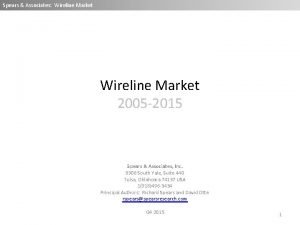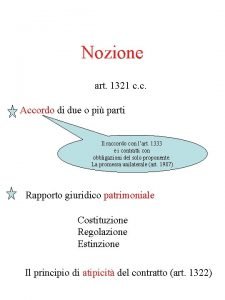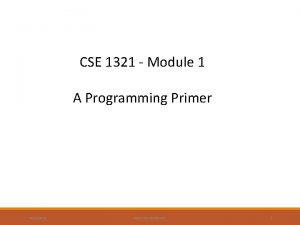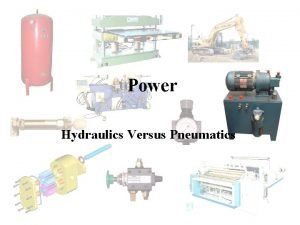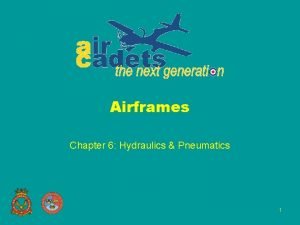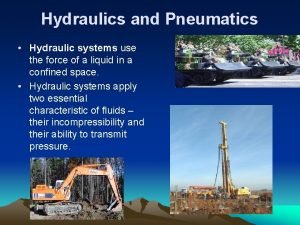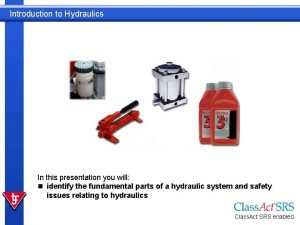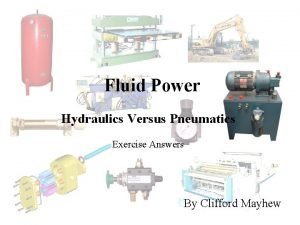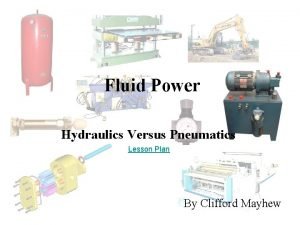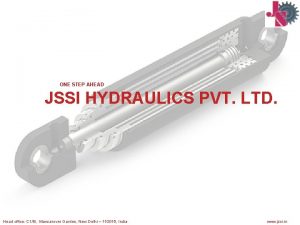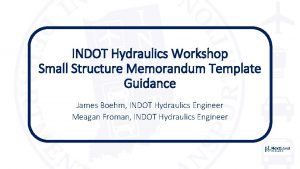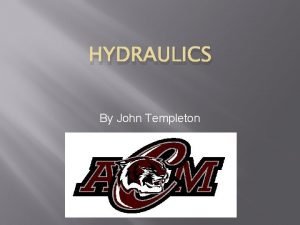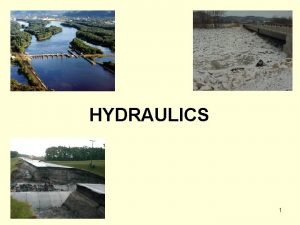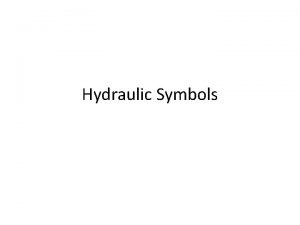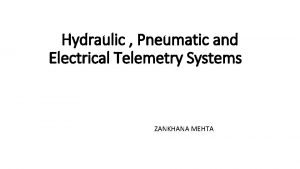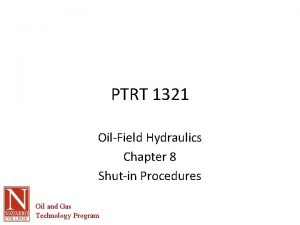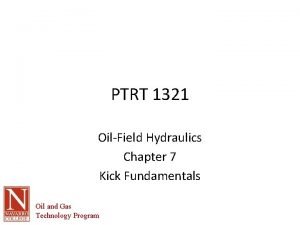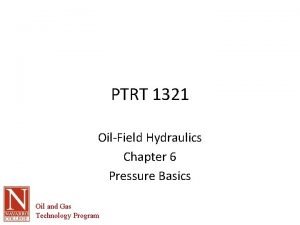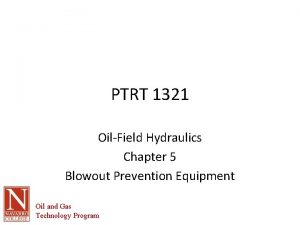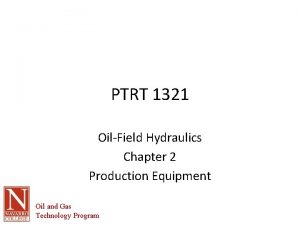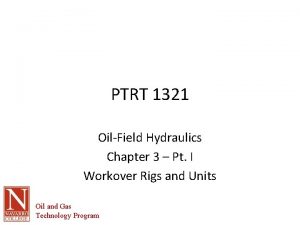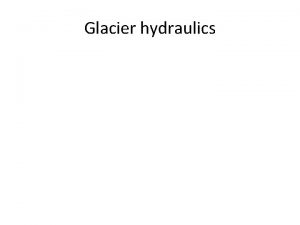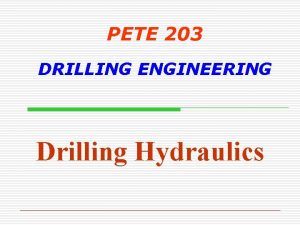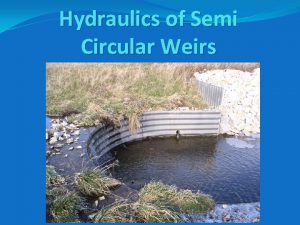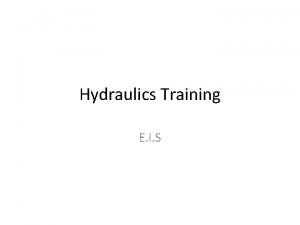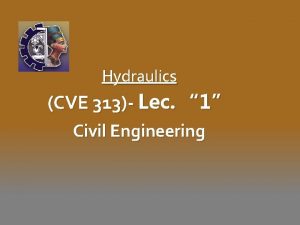PTRT 1321 OilField Hydraulics Chapter 4 Completion and



























- Slides: 27

PTRT 1321 Oil-Field Hydraulics Chapter 4 Completion and Workover Fluids Oil and Gas Technology Program

Fluid Characteristics • Density – High enough to control well pressures – Low enough to avoid formation fracture • Cost-effective – Expensive sometimes required to avoid formation damage – Less expensive alternatives can be selected with sufficient expertise • • Free from solid particles Non-corrosive Stable Avoid precipitation of solids in formation (filtered or cleaned)(matched to formation properties) Oil and Gas Technology Program

Fluid Spacers • Separate incompatible fluids from one another – Salt water – Special muds • Injected as a slug in between the two incompatible fluids – Acids – Cement slurries Oil and Gas Technology Program

Fluid Functions • Typical fluids are not unusual or exotic • Several important functions – – – – Transport of materials into and out of the well Suspension of materials in static conditions Pressure control Absorption of heat plus lubrication Delivery of hydraulic energy Energy transfer medium for logging or perforating tools Avoiding damage of • Formations • Downhole and surface equipment • Personel and the environment Oil and Gas Technology Program

Transport of Materials • Materials circulated into and out of the well – – – – Acid Cement Gelled pills Plastic Gravel Frac sand Sealers • Potentially damaging materials Oil and Gas Technology Program – – – – Dry cement Corrosive fluids Cuttings Debris Gravel Gas Metals Contaminated mud

Suspension of Materials • Thixotropic behavior (gel when static, fluid when flowing) • Gel properties prevent settling when static • High gel strength can produce excessive swab and surge pressures (think of friction) – Cause formation kick or breakdown – Control steps for either can damage formation • Reverse circulation is used Oil and Gas Technology Program

Pressure Control • Most work requires killing the well – Formation pressure balanced by hydrostatic fluid pressure • Weighted materials – Clay – Barite • Excess pressure can damage formation Oil and Gas Technology Program

Other Items • Fluid mass absorbs heat of friction • Only means of delivering hydraulic energy (pressure) from the rig pumps down hole • Optimum thickness, viscosity, solids content, etc allow easy transport and operation of downhole tools Oil and Gas Technology Program

Avoiding Damage • Formation damage – Silts, fines, sludges, or gums – No change in wettability of the rock • Most are water-wet (salt water) • Some are oil-wet • Fresh water can cause emulsions to form and reduce permeability • Formation swelling or scale formation can also reduce permeability • Corrosion and environmental hazards Oil and Gas Technology Program

Types of Completion and Workover Fluids • Oil Fluids – 7 ppg – excellent for low pressure oilwells – Disadvantages • Wax • Sand, solids, or asphalt • Corrosive if H 2 S or CO 2 present – Potential fire hazard • Diesel or kerosene sometimes used • Environmental hazard Oil and Gas Technology Program

Types of Completion and Workover Fluids • Oil-emulsion Fluids – Oil-in-water emulsion most common – Water phase either fresh or salt water – Emulsifying agents for stability • Starch, soap, organic colloids – Diesel most common oil used • Cost effective • Less damaging to formation Oil and Gas Technology Program

Types of Completion and Workover Fluids • Gas Fluids – Can be used in some low pressure reservoirs – Flow controlled using surface back-pressure • Natural gas commonly used – Readily available – Cheap – Hazardous (flammable) • Nitrogen – inert (non-reactive) • Foams added to assist with suspension of trash and other solids Oil and Gas Technology Program

Types of Completion and Workover Fluids • Water-based Fluids – Fresh water (seldom used) – Salt water (brine) – Water-based muds • Low-salinity water – Plentiful – Inexpensive – Requires little treatment – Filtration can remove suspended solids Oil and Gas Technology Program

Brines • Salt dissolves in water – Density increases – Increased hydrostatic head – No suspended solids (as long as all the salt is dissolved) • Usually inhibits clay hydration (swelling) • In cases where hydration occurs when Na. Cl is used, Ca. Cl 2 or KCl can be used • Single-salt brines using Ca. Br 2 and Zn. Br 2 can be used to form a high-density brine Oil and Gas Technology Program

Oil and Gas Technology Program

Saturation • Salt can be added to increase density only until a saturation point at a given temperature is reached • Beyond saturation the salt drops out of solution by crystallization or by settling out as undissolved solids • If saturation is reached with a low density solution a higher density salt may be added to increase the density Oil and Gas Technology Program

Oil and Gas Technology Program

Density Changes • Density decreases with increasing temperature – density quoted at 60 ⁰F • Temperature increases with well depth (up to 400 ⁰F in some cases) – can cause dramatic density decreases D 60 = Dwb + (Tav – 60)(k/100) K = temperature correction factor Oil and Gas Technology Program

Oil and Gas Technology Program

Example • Bottomhole temperature = 220 ⁰F • Require a 9. 9 ppg brine • With a surface temp of 60 ⁰F what density of brine is required? = 9. 9 + (140 – 60)(0. 2/100) = 10. 1 ppg Oil and Gas Technology Program

Water-base Muds • Combination of water, clays and chemicals • Sometimes used in workover and completion • Laden with solids that can damage formations through water loss and blocking pore spaces • Used because they are low cost and often easier to work with Oil and Gas Technology Program

Packer Fluids • Fluid in the annular space between the tubing and casing. This packer fluid: – Provides formation pressure control – Prevents casing collapse – Prevents production string from bursting • The packer fluid must be: – – – – Noncorrosive Stable with time and temperature Economical Pumpable when placed and remain pumpable Sufficient density Cause no damage to packer seals Able to keep solids suspended • Many good packer fluids are currently available Oil and Gas Technology Program

Plugs (Pills) • Plugs or Pills are used in similar ways as mechanical plugs – Seal casing leaks – Correct injection profile in water-injection or disposal wells – Stop lost circulation – Divert acid during well cleanup – Shut off saltwater flows • Plugs can also be used: – stabilize unconsolidated gravel zones – Seal fractures Oil and Gas Technology Program

Types of Fluids • Soft and pumpable fluid available – – – – – Neat cement Thickened oil-base mud Diesel oil-cement Diesel oil-bentonite Bentonite-cement Silica-clay Polymers Plastics Acids Other lost circulation chemicals • Weighting materials and viscosifiers can also be added to make then dense and highly viscous • Retarder or accelerator can also be used as needed Oil and Gas Technology Program

Other intricacies • Time-delayed, self-complexing plug • A breaker can be used to provide a predictable breakdown of the plug – Polymer pill with an enzyme added; e. g. break down complex polysaccharide polymer (cooked starch) into low-molecular-weight polymers (digested starch) plus simple sugar – Amylase is one such enzyme Oil and Gas Technology Program

Example • Dual completion well in which one of the two producing zones requires a relatively high density fluid to kill it. • This will cause lost circulation in the other producing zone (permeability is higher or formation pressure is much lower) • Spot a plug in the weak zone to seal it with a breaker added so it dissolves when the zone is ready to be produced Oil and Gas Technology Program

General Fluid Safety • HAZCOM • PPE – Goggles – Splash protection – Gloves – Boots • Mixing chemical into water NEVER the other way around Oil and Gas Technology Program
 Spears and associates oilfield market report
Spears and associates oilfield market report Spears & associates oilfield market report
Spears & associates oilfield market report L&j oilfield services
L&j oilfield services Digital oilfield solution
Digital oilfield solution Oilfield hos rules
Oilfield hos rules Causa del contratto
Causa del contratto Risoluzione
Risoluzione Cse 1321
Cse 1321 Gradescope ksu
Gradescope ksu Cse 1321
Cse 1321 Parabola del trigo y la cizaña enseñanza
Parabola del trigo y la cizaña enseñanza 1321-1265
1321-1265 Cse 1321
Cse 1321 Hydraulics and pneumatics symbols
Hydraulics and pneumatics symbols Hydraulic advantages
Hydraulic advantages Hydraulic and pneumatics
Hydraulic and pneumatics Hydraulic presentation
Hydraulic presentation Fluid power terms crossword
Fluid power terms crossword Fluid power hydraulics and pneumatics
Fluid power hydraulics and pneumatics Www.mhhe.com/yacht 2019
Www.mhhe.com/yacht 2019 Accounting chapter 4
Accounting chapter 4 Jssi hydraulics
Jssi hydraulics Indot design memo
Indot design memo Hydraulics definition
Hydraulics definition Hydraulics definition
Hydraulics definition Flow meter hydraulic symbol
Flow meter hydraulic symbol Pneumatics vs hydraulics
Pneumatics vs hydraulics Mehta hydraulics
Mehta hydraulics

